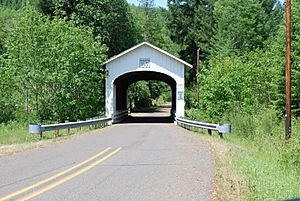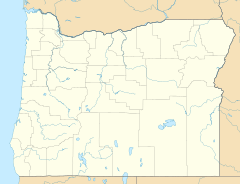Wendling, Oregon facts for kids
Quick facts for kids
Wendling, Oregon
|
|
|---|---|

Wendling Bridge, a covered bridge over Mill Creek
|
|
| Country | United States |
| State | Oregon |
| County | Lane |
| Elevation | 646 ft (197 m) |
| Time zone | UTC-8 (Pacific (PST)) |
| • Summer (DST) | UTC-7 (PDT) |
| ZIP code |
97454
|
| Area code(s) | 458 and 541 |
| GNIS feature ID | 1136886 |
Wendling is a small, undeveloped area in Lane County, Oregon, United States. It is located northeast of Marcola. An "unincorporated community" means it's a place with a name but no official local government like a city or town.
Wendling had its own post office from 1899 until 1952. The community was named after George X. Wendling. He was an important investor from San Francisco. He put a lot of money into the Booth-Kelly Lumber Company's plans in the Mohawk area. Wendling was originally built as a "company town." This means a company, in this case, Booth-Kelly Lumber, built and owned most of the homes and buildings for its workers.
Contents
History of Wendling
The Booth-Kelly Lumber Company first planned to float logs down the Mohawk River to a new mill. This mill was going to be near a place called Coburg. Lane County even gave them permission to use the river for 90 years. However, other mills, loggers, and farmers in the area strongly disagreed with this plan.
Because of this, Booth-Kelly decided to build their mill closer to where the trees were. They needed to get permission to build a railroad track. This track would go from Springfield to their chosen spot. Once they had the permission, they started building the mill and other structures in the fall of 1899. The railroad was finished, and the first train arrived in Wendling on September 3, 1900.
Fires in Wendling
Wendling faced several big fires over the years. These fires caused a lot of damage to the community.
The 1910 Forest Fire
On the night of August 24-25, 1910, hot embers from a nearby forest fire fell on Wendling. Almost all the company-owned houses were destroyed. Only three homes were saved. The church, school, cookhouse, and bunkhouse also burned down. Luckily, the main mill, the store, and the company offices were saved. Booth-Kelly quickly rebuilt everything within two months. They kept the mill and logging camps working during this time.
The 1917 Planer Mill Fire
In the morning of September 26, 1917, another fire broke out. This time, the planer mill and the dry sheds were completely burned down. A planer mill is where lumber is smoothed and shaped. The main sawmill and other buildings were saved from this fire.
The 1922 Sawmill Fire
On the morning of July 6, 1922, the sawmill itself was destroyed by fire. The nearby kilns, which are ovens used to dry wood, also burned down. This was a major loss for the company.
The 1946 Mill Superstructure Fire
Months after the mill in Wendling had closed, and most of its equipment had been removed, a final fire occurred. On September 29, 1946, the main mill buildings and the powerhouse burned. No other buildings in the community were lost in this fire.
The Wendling Bridge
The Wendling Bridge is a special kind of bridge called a covered bridge. It carries Wendling Road over Mill Creek in Wendling. This bridge was built in 1938. It is considered historically important. In 1979, it was added to the National Register of Historic Places. This list recognizes places that are important to the history of the United States.



